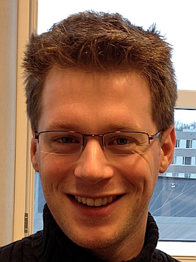Alternative lithography strategies for flex electronics
Promotion date: 4. July 2012
Promotor: Prof. dr. ir. Jurriaan Huskens
| Aim of research has been the development of alternative lithography strategies for the fabrication of complex, flexible electronic devices. Flexible bottom-contact, bottom-gate thin-film transistors were solely patterned with UV nanoimprint lithography (NIL) on poly(ethylene naphthalate) foil. Patterning and process strategies had to be developed, for thermal and UV NIL, to control the residual layer thickness and its complete removal on the temperature sensitive, mechanically and in-plane instable foils. TFTs with a channel length from 5 µm down to 250 nm were obtained and characterized. Palladium nanoparticles and self-sintering silver nanoparticles were studied as a solution-based route for fast, low-cost and room temperature patterning of metallic wires on flexible foils. The here studied fabrication methods can be potentially integrated in low-cost, high-throughput roll-to-roll fabrication lines, and represent, in combination with a self-aligned device layout, a strategy for future generations of flexible electronic devices. |
Was your thesis project application oriented as well?
Nanoimprint lithography is, say, one of the ten next generation lithography techniques for future information technologies. It is potentially a low-cost patterning technique, when processed in a high throughput roll-to-roll process for example. Writing structures as small as five nanometers is feasible, though for industry standards the defect control - allowing only one out of ten thousand structures or better to show a defect - remains a challenge for large-scale nanoimprint lithography.
Aim here was to build a four-layered transistor on a flexible foil with only UV nanoimprint lithography as patterning technique, ending up with TFTs on foil. Especially the waviness and mechanical instability of the flexible foils complicated processing. Foils were temporarily bonded to a carrier and a flat plateau was imprinted on top of the foil, in order to form homogeneous residual layers that allowed multiple, aligned imprinting on the same spot. Next to this top-down technique, few materials were studied which are potentially interesting for a bottom-up technique. For example, were the patterning capabilities of a room-temperature sintering, silver nanoparticle ink studied.
Low-cost and commercially available PET- and PEN-foils were used. The latter can withstand higher temperatures, which is advantageous for following processing steps requiring heat.
The research was subsidized by the Holst Centre in Eindhoven. Here at Mesa+, we can bring in specific expertise and use seldom lab equipment, such as the UV nanoimprint lithography apparatus Imprio® 55.
Was there a special moment during your thesis project that you recall?
After making progress on successive steps in the process, after 3.5 years of work I was finally able to characterize the so wanted I-V-curvature from the fully imprinted, flexible TFTs. This was a big moment for me, really being able to have a proof of principle of the transistor built. A lot of experiments went up in smoke literally, simple as the dielectric layers burned through due to short circuits.
What kind of expertise did you need to come to these results?
The expertise of one of the Holst Centre groups was needed, to deposit the dedicated semiconductor by inkjet printing as final step in the fabrication process.
Here, a lot of talks with experts were involved, choosing the right strategies of experiments and building the device. The technical operators possess lots of experience and knowledge. I soon found out, for example, that using sputtering techniques on SiO2 isn’t such a good idea, as temperatures needed are too high for this type of foil substrates.
Did you succeed in publishing your work?
An article was accepted in Organic Electronics and one in ACS Applied Materials and Interfaces. Two articles are still to be submitted. I was a speaker on various conferences, like the Materials Research Society Conference in Boston.
What are your future plans?
I now work as a post-doc on a different subject involving protein printing. After that, I like to go abroad and see if I can build up challenging research skills elsewhere.
In the long run, I suppose a job at a research institute suits me most, but the final goal is not yet clear.
What is, in your opinion, important for Mesa+ to stay successful in future?
One of the interesting features working for Mesa+ is the contacts one can build up while working here, for example with the experts in the cleanroom and also the experts form spin-off companies involved, like Lionix. Most people are willing to share their expertise, provided you come up with targeted and relevant research questions.
Helping each other out for small first trial experiments is a common thing. For example, I worked on ion-beam etching together with an operator and another PhD fellow.
It is important for Mesa+ to try and find new research talent in PhD projects. Here in the Netherlands the wages and working conditions are excellent as compared to other countries. Mesa+ should really invest in science and research and leave out overdone administration and glossy folders and flyers, in my opinion.
When I started in my group, I was the only PhD from the Netherlands involving forty group members. With now in total seven researchers from the Netherlands, we have a very nice and inspiring mix of international researchers.

